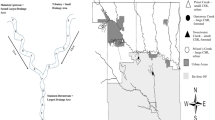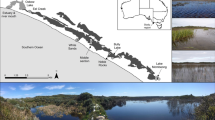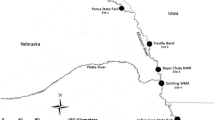Abstract
We identified in-stream and off-stream characteristics that influenced various species diversity metrics in reaches of the Duck River Basin, Tennessee, USA. This relatively small basin is home to one of the most diverse freshwater fish faunas in North America. In all, over 325,000 native fish representing 136 native fish species were electrofished in 207 collections across 86 stations. Diversity of native species and of seven taxa and functional guilds, including imperiled species, increased with size of the catchment above a station, an effect that was mediated by altitude. After removing the effects of catchment and altitude, diversity was influenced by in-stream factors and mostly by off-stream land composition such as wetlands within 0.1 km from the channel and urban/suburban development within 2.5 km. Pastures next to streams unexpectedly increased diversity. Our analyses suggest that there are detectable hotspots associated with off-stream landscape characteristics where conservation efforts may be focused. Our results may encourage conservation planners to apply geospatial analyses to identify diversity hotspots based on land cover distributions and develop recommendations for management of specific stream reaches. Alternatively, geospatial analysis may be used by planners to estimate the impacts of alternative land-use scenarios, thus preemptively conserving species richness.


Similar content being viewed by others
References
Abell R, Allan JD, Lehner B (2007) Unlocking the potential of protected areas for freshwaters. Biol Conserv 134:48–63
Ahlstedt SA, Powell JR, Butler RS, Fagg MT, Hubbs DW, Novak SF, Palmer SR, Johnson PD (2017) Historical and current examination of freshwater mussels (Bivalvia: Margaritiferidae: Unionidae) in the Duck River basin Tennessee, U. SA Malacol Rev 45:1–163
Al-Chokhachy R, Roper BB, Archer EK (2010) Evaluating the status and trends of physical stream habitat in headwater streams within the interior Columbia River and Upper Missouri River basins using an index approach. Trans Am Fish Soc 139:1041–1059
Alig RJ, Kline JD, Lichtenstein M (2004) Urbanization on the US landscape: looking ahead in the 21st century. Landscape Urban Plan 69:219–234
Allan JD (2004) Landscapes and riverscapes: the influence of land use on stream ecosystems. Annu Rev Ecol Evol Syst 35:257–284
Angermeier PL (1995) Ecological attributes of extinction-prone species: loss of freshwater fishes of Virginia. Conserv Biol 9:143–158
Barbosa AM, Brown JA, Jimenez-ValverdeA, Real R (2016) ModEvA: model evaluation and analysis. R package version 1.3.2. https://CRAN.R-project.org/package=modEvA. Acessed 15 July 2018
Barton K (2016) MuMIn: multi-model inference. R package version 1.15.6. https://CRAN.R-project.org/package=MuMIn. Acessed 15 July 2018
Bates D, Maechler M, Bolker B, Walker S (2015) Fitting linear mixed-effects models using lme4. J Stat Softw 67:1–48
Belliard J, Boët P, Tales E (1997) Regional and longitudinal patterns of fish community structure in the Seine River basin, France. Environ Biol Fish 50:133–147
Boijsen BH, Barriga R (2002) Effects of deforestation on fish community structure in Ecuadorian Amazon streams. Freshw Biol 47:2246–2260
Brosse S, Beauchard O, Blanchet S, Durr HH, Grenouillet G, Hugueny B, Lauzeral C, Leprieur F, Tedesco PA, Villeger S, Oberdorff T (2013) Fish-SPRICH: a database of freshwater fish species richness throughout the world. Hydrobiologia 700:343–349
Brown DG, Johnson KM, Loveland TR, Theobald DM (2005) Rural land-use trends in the conterminous United States, 1950-2000. Ecol Appl 15:1851–1863
Case TJ (1991) Invasion resistance, species build-up and community collapse in metapopulation models with interspecies competition. Biol J Linn Soc 42:239–266
Collares-Pereira MJ, Cowx IG (2004) The role of catchment scale environmental management in freshwater fish conservation. Fish Manage Ecol 11:303–312
Dudgeon D, Arthington AH, Gessner MO, Kawabata Z-I, Knowler DJ, L’evˆeque C, Naiman RJ, Prieur-Richard A-H, Soto D, Stiassny ML, Sullivan CA (2006) Freshwater biodiversity: importance, threats, status and conservation challenges. Biol Rev 81:163–182
ESRI (2011) ArcGIS Desktop 10.0. Environmental Systems Research Institute, Redlands, California
Etnier DA, Starnes WC (1993) The fishes of Tennessee. The University of Tennessee Press, Knoxville
Fernandes IM, Lourenço LS, Ota RP, Moreira MMM, Zawadzki CH (2013) Effects of local and regional factors on the fish assemblage structure in meridional Amazonian streams. Environ Biol Fish 96:837–848
Fox J, Weisberg S (2011) An {R} companion to applied regression, second edition. Sage
Franssen NR, Gido KB, Guy CS, Tripe JA, Shrank SJ, Strakosh TR, Bertrand KN, Franssen CM, Pitts KL, Paukert CP (2006) Effects of floods on fish assemblages in an intermittent prairie stream. Freshw Biol 51:2072–2086
Frissell CA, Liss WJ, Warren CE, Hurley MD (1986) A hierarchical framework for stream habitat classification: viewing streams in a watershed context. Environ Manag 10:199–214
Gesch D, Oimoen M, Greenlee S, Nelson C, Steuck M, Tyler D (2002) The national elevation dataset. Photogramm Eng Remote Sens 68:5–32
Gido KB, Brown JH (1999) Invasion of north American drainages by alien fish species. Freshw Biol 42:387–399
Goldstein RM, Wang L, Simon TP, Stewart PM (2011) Development of a stream habitat index for the Northern Lakes and forests ecoregion. N Am J Fish Manage 22:452–464
Harding JS, Benfield EF, Bolstad PV, Helfman GS, Jones EBD (1998) Stream biodiversity: the ghost of land use past. Proc Natl Acad Sci 95:14843–14847
Hewitt AH, Kwak TJ, Cope WG, Pollock KH (2009) Population density and instream habitat suitability of the endangered Cape Fear Shiner. Trans Am Fish Soc 138:1439–1457
Homer CG, Dewitz JA, Yang L, Jin S, Danielson P, Xian G, Coulston J, Herold ND, Wickham JD, Megown K (2015) Completion of the 2011 National Land Cover Database for the conterminous United States-Representing a decade of land cover change information. Photogramm Eng Remote Sens 81:345–354
Hopkins RL (2009) Use of landscape pattern metrics and multiscale data in aquatic species distribution models: a case study of a freshwater mussel. Landsc Ecol 24:943–955
Horwitz RJ (1978) Temporal variability patterns and the distributional patterns of stream fishes. Ecol Monogr 48:307–321
Jacobsen D, Dangles O (2017) Ecology of high altitude waters. Oxford University Press, Oxford
Jelks HL, Walsh SJ, Burkhead NM, Contreras-Balderas S, Diaz-Pardo E, Hendrickson DA, Lyons J, Mandrak NE, McCormick F, Nelson JS, Platania SP, Porter BA, Renaud CB, Schmitter-Soto J, Taylor EB, Warren ML Jr (2008) Conservation status of imperiled north American freshwater and diadromous fishes. Fisheries 33:372–407
Jenkins RE, Burkhead NM (1994) Freshwater fishes of Virginia. In: American fisheries society. Bethesda, Maryland
Jones EBD III, Helfman GS, Harper JO, Bolstad PV (1999) Effects of riparian forest removal on fish assemblages in southern Appalachian streams. Conserv Biol 13:1454–1465
Kéry M (2010) Introduction to WinBUGS for ecologists: Bayesian approach to regression, ANOVA, mixed models and related analyses. Academic Press, Cambridge
Knight RR, Kingsbury JA (2007) Water resources of the Duck River watershed, Tennessee. U.S. Geological Survey Scientific Investigations Report 2007–5105, Reston, Virginia
Lammert M, Allan JD (1999) Assessing biotic integrity of streams: effects of scale in measuring the influence of land use/cover and habitat structure on fish and macroinvertebrates. Environ Manag 23:257–270
Magurran A (2004) Measuring biological diversity. Blackwell Publishing, Hoboken
Matthews WJ (1998) Patterns in freshwater fish ecology. Chapman and Hall
Meador MR, Carlisle DM (2007) Quantifying tolerance indicator values for common stream fish species of the United States. Ecol Indic 7:329–338
Moilanen A, Leathwick J, Elith J (2008) A method for spatial freshwater conservation prioritization. Freshw Biol 53:577–592
Myers N, Mittermeier RA, Mittermeier CG, da Fonseca GAB, Kent J (2000) Biodiversity hotspots for conservation priorities. Nature 403:853–858
Nakagawa S, Schielzeth H (2013) A general and simple method for obtaining R2 from generalized linear mixed-effects models. Methods Ecol Evol 4:133–142
O'Hara RB (2009) How to make models add up: a primer on GLMMs. Ann Zool Fennici 46:124–137
Pease A, Taylor JM, King RS, Winemiller KO (2011) Environmental influences on fish community structure at multiple spatial scales in Central Texas streams. Trans Am Fish Soc 140:1409–1427
Poff NL (1997) Landscape filters and species traits: towards mechanistic understanding and prediction in stream ecology. J N Am Benthol Soc 16:391–409
Pruitt BA, Killgore KJ, Slack WT (2018) Duck River watershed plan, final watershed assessment. U.S Army Corps of Engineers, Nashville District, Tennessee
R Core Team (2017) R: A language and environment for statistical computing. R Foundation for Statistical Computing, Vienna, Austria. Available online: https://www.R-project.org/. Acessed 15 July
Rankin ET (1995) Habitat indices in water resource quality assessments. Biological Assessment and Criteria, Tools for Water Resource Planning (eds W. S. Davis and T. P. Simon), pp. 181–208. Lewis Publishers
Reid WV (1998) Biodiversity hotspots. Trends Ecol Evol 13:275–280
Reyjol Y, Hugueny B, Pont D, Bianco PG, Beier U, Caiola N, Casals F, Cowx I, Economou A, Ferreira T, Haidvogl G, Noble R, De Sostoa A, Vigneron T, Virbickas T (2007) Patterns in species richness and endemism of European freshwater fish. Glob Ecol Biogeogr 16:65–75
Rosenzweig ML (1995) Species diversity in space and time. Cambridge University Press
Roth NE, Allan JD, Erickson DL (1996) Landscape influences on stream biotic integrity assessed at multiple spatial scales. Landsc Ecol 11:141–156
Rowe DC, Pierce CL, Wilton TF (2009) Physical habitat and fish assemblage relationships with landscape variables at multiple spatial scales in wadeable Iowa streams. N Am J Fish Manage 29:1333–1351
Schielzeth H (2010) Simple means to improve the interpretability of regression coefficients. Methods Ecol Evol 1:103–113
Schilling EM, Williams JD (2002) Freshwater mussels (Bivalvia: Margaritiferidae and Unionidae) of the lower Duck River in middle Tennessee: a historic and recent review. Southeast Nat 1:403–414
Schlosser IJ (1991) Stream fish ecology: a landscape perspective. BioScience 41:704–712
Scott MC (2006) Winners and losers among stream fishes in relation to land use legacies and urban development in the southeastern US. Biol Conserv 127:301–309
Simon TP (1999) Assessing the sustainability and biological integrity of water resources using fish communities. CRC Press, Boca Raton
Smith TS, Kraft CE (2005) Stream fish assemblages in relation to landscape position and local habitat variables. Trans Am Fish Soc 134:430–440
Snyder CD, Young JA, Villella R, Lemarie DP (2003) Influences of upland and riparian land use patterns on stream biotic integrity. Landsc Ecol 18:647–664
Taylor CM (1997) Fish species richness and incidence patterns in isolated and connected stream pools: effects of pool volume and spatial position. Oecologia 110:560–566
Townsend CR, Downes BJ, Peacock K, Arbuckle CJ (2004) Scale and the detection of land-use effects on morphology, vegetation and macroinvertebrate communities of grassland streams. Freshw Biol 49:448–462
TVA (2005) Protocol for conducting an index of biotic integrity biological assessment. Tennessee Valley Authority, Knoxville
USGS (2014) U.S. Geological Survey national hydrography dataset. Available online: https://nhd.usgs.gov. Accessed February 2018
Wang L, Lyons J, Kanehl P, Gatti R (1997) Influences of watershed land use on habitat quality and biotic integrity in Wisconsin streams. Fisheries 22:6–12
Wang L, Lyons J, Kanehl P (2001) Impacts of urbanization on stream habitat and fish across multiple spatial scales. Environ Manag 28:255–266
Wang L, Seelbach PW, Lyons J (2006) Effects of levels of human disturbance on the influence of catchment, riparian, and reach-scale factors on fish assemblages. Am Fish Soc Symp 48:199–219
Wantzen KM, Junk WJ (2000) The importance of stream-wetland-systems for biodiversity: a tropical perspective. In: Gopal B, Junk WJ, Davies JA (eds) Biodiversity in wetlands: assessment, function and conservation. Backhuys, Leiden, pp 11–34
Warren ML, Angermeier PL, Burr BM, Haag WR (1997) Decline of a diverse fish fauna: patterns of impediment and protection in the southeastern United States. In: Benz GW, Collins DE (eds) Aquatic fauna in peril: the southeastern perspective. Southeast Aquatic Research Institute Special Publication 1, Decatur, pp 105–164
Wheeler AP, Angermeier PL, Rosenberger AE (2006) Impacts of new highways and subsequent landscape urbanization on stream habitat and biota. Rev Fish Sci 13:141–164
Zuur AF, Ieno EN, Walker NJ, Saveliev AA, Smith GM (2009) Mixed effects models and extensions in ecology with R. Springer
Zuur AF, Ieno EN, Elphick CS (2010) A protocol for data exploration to avoid common statistical problems. Methods Ecol Evol 1:3–14
Acknowledgements
This research was funded by the Nashville District of the Army Corps of Engineers, by Mississippi State University, and by the U.S. Geological Survey. The fish database was provided by Tennessee Valley Authority (E. Crews and T. O’Quinn) along with descriptions of the protocols used in data collection. We appreciate helpful comments by C. Saylor and R. Wallus on field data collections. Thanks to C. Aldridge and C. Jennings for helpful reviews. Any use of trade, firm, or product names is for descriptive purposes only and does not imply endorsement by the U.S. Government.
Author information
Authors and Affiliations
Corresponding author
Additional information
Publisher’s note
Springer Nature remains neutral with regard to jurisdictional claims in published maps and institutional affiliations.
Rights and permissions
About this article
Cite this article
Miranda, L.E., Martínez-Lanfranco, J.A. & Killgore, K.J. Wetlands and development influence fish diversity in a species-rich small river. Environ Biol Fish 102, 873–886 (2019). https://doi.org/10.1007/s10641-019-00876-5
Received:
Accepted:
Published:
Issue Date:
DOI: https://doi.org/10.1007/s10641-019-00876-5




